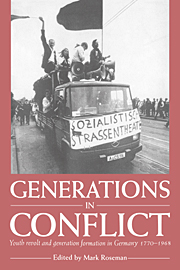Book contents
- Frontmatter
- Contents
- Contributors
- Acknowledgements
- List of abbreviations
- 1 Introduction: generation conflict and German history 1770–1968
- 2 The ideal of youth in late eighteenth-century Germany
- 3 Young Germans and Young Germany: some remarks on the history of German youth in the late eighteenth and in the first half of the nineteenth century
- 4 The battle for the young: mobilising young people in Wilhelmine Germany
- 5 Jewish politics and generational change in Wilhelmine Germany
- 6 The ‘front generation’ and the politics of Weimar Germany
- 7 The New Woman and generation conflict: perceptions of young women's sexual mores in the Weimar Republic
- 8 Generations of German historians: patronage, censorship and the containment of generation conflict 1918–1945
- 9 Gender, generation and politics: young Protestant women in the final years of the Weimar Republic
- 10 The Hitler Youth generation and its role in the two post-war German states
- 11 The BDM generation: a female generation in transition from dictatorship to democracy
- 12 A generation twice betrayed: youth policy in the transition from the Third Reich to the Soviet Zone of Occupation (1945–1946)
- 13 The generation conflict that never was: young labour in the Ruhr mining industry 1945–1957
- 14 The German Kriegskinder: origins and impact of the generation of 1968
- Index
10 - The Hitler Youth generation and its role in the two post-war German states
Published online by Cambridge University Press: 19 October 2009
- Frontmatter
- Contents
- Contributors
- Acknowledgements
- List of abbreviations
- 1 Introduction: generation conflict and German history 1770–1968
- 2 The ideal of youth in late eighteenth-century Germany
- 3 Young Germans and Young Germany: some remarks on the history of German youth in the late eighteenth and in the first half of the nineteenth century
- 4 The battle for the young: mobilising young people in Wilhelmine Germany
- 5 Jewish politics and generational change in Wilhelmine Germany
- 6 The ‘front generation’ and the politics of Weimar Germany
- 7 The New Woman and generation conflict: perceptions of young women's sexual mores in the Weimar Republic
- 8 Generations of German historians: patronage, censorship and the containment of generation conflict 1918–1945
- 9 Gender, generation and politics: young Protestant women in the final years of the Weimar Republic
- 10 The Hitler Youth generation and its role in the two post-war German states
- 11 The BDM generation: a female generation in transition from dictatorship to democracy
- 12 A generation twice betrayed: youth policy in the transition from the Third Reich to the Soviet Zone of Occupation (1945–1946)
- 13 The generation conflict that never was: young labour in the Ruhr mining industry 1945–1957
- 14 The German Kriegskinder: origins and impact of the generation of 1968
- Index
Summary
The term ‘Hitler Youth’ conjures up images of a paramilitary organisation turning boys into men – ‘hard as Krupp steel and quick as lightning’. And the girls, so the cliché would have it, were educated to be good German mothers, happy within their domain of home and hearth, a domain subordinate to the larger world of men just as the League of German Girls (BDM) was a subdivision of the larger organisation of the Hitler Youth (HJ). That, at any rate, is the conventional picture. But such a crude caricature tells us little about the real experiences of the millions of boys and girls who were members of the HJ or about the significance of those experiences for shaping social behaviour and attitudes in the two post-war German states.
How, then, did the almost nine million boys and girls in the HJ and BDM experience the Nazi youth organisations? Accounts of the period tend to dwell on ‘camp fire romanticism’, on the appeal of a ‘youthful community’, on sport and games, sometimes on paramilitary drill or political education. Only rarely do they tell us whether the HJ was accepted or rejected by its members. Until very recently, the historiography of the Third Reich neglected such central questions as what in retrospect was seen as positive or negative in the HJ. How did the HJ generation subsequently interpret and deal with the experiences of those years? How did those experiences shape their subsequent lives and, through them, the society in which they lived?.
- Type
- Chapter
- Information
- Generations in ConflictYouth Revolt and Generation Formation in Germany 1770–1968, pp. 210 - 226Publisher: Cambridge University PressPrint publication year: 1995
- 1
- Cited by



